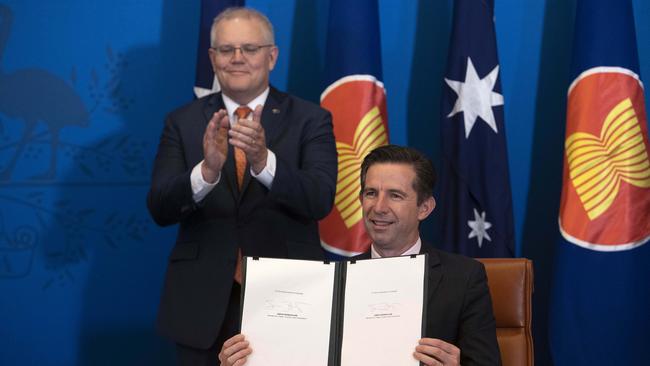
Accordingly, we must concentrate on our current advantages, and there is no bigger advantage than the recently signed Regional Comprehensive Economic Partnership (RCEP).
What makes RCEP unique is that many of its members — including China, South Korea, Australia and New Zealand — have low COVID-19 infection rates, so its economic recovery rates will be faster than Europe and the Americas.
Even more importantly, RCEP has the opportunity to be the first regional trade group in the world to be based on uniform digitised trade communication and quality monitoring.
While the percentage of physical goods in world trade is in decline because of the rising trade in software and services, by standardising trade communication and monitoring systems RCEP can maintain its ranking as the fastest-growing area of the world.
Some five or 10 years ago, the vast majority of trade documentation was paper-based. In the past few years this has been transformed, but shipping companies and some local customs operations in many countries in the RCEP region have been lagging.
It would be an enormous achievement if trade in the region was all digitally based and using the same system.
And it doesn’t require change on politically sensitive issues of tariffs and subsidies, which will take longer, particularly given the China-US rivalry.
An essential part of uniform technology is the application of blockchain and other digital technologies to establish that goods at the point of exit match both the relevant order and the destination’s import rules. With that as a starting point, technology can be introduced to closely monitor goods on their journey.
That way there is total predictability and confidence that goods on delivery will meet the required specifications.
At the moment, China is playing games to punish Australia for its attacks. So goods are being blocked at random. But sometimes those trade blocks are linked to alleged deficiencies in the quality of the goods.
If an agreed system was in place under RCEP, that excuse would not be available unless there was documented adversity on the journey to China.
As these RCEP uniform systems are developed, one of the difficulties likely to be encountered is that there are two telecommunications systems operating in the world: the European/American system that has been imposed on Australia by the US for security reasons, and China’s system, which involves Huawei. Singapore has followed Australia and somewhat reluctantly Japan is in the same situation. But South Korea does not want to follow the American line because it will affect many of its major corporations and their trade with China.
And this underlines the dilemma for the region given: China is the biggest market and will be pushing for its system to be embraced.
The outcome may depend on which systems are applied to trade by Japan, South Korea as well Australia and New Zealand. Of course, it may be possible for both systems to happily coexist.
Australian exporters and importers looking to digitise their operations often do it themselves, but a number of groups are emerging to assist the process.
New Zealand has been one of the leaders in the region in digitisation and its TradeWindow group, in which Commonwealth Bank has a 23 per cent interest, now dominates the NZ market. And TradeWindow is now expanding rapidly into the competitive Australian market.
Australia, via Melbourne-based Airwallex, is a major regional player in trade currency management, which must also be part of the low-cost movement of money in regional trade.
Groups like Airwallex are also providing payment systems for smaller enterprises involved in regional trade. Again, that process is made easier if there is digitised standard for trade flows.
One of the biggest markets that will be developed in the region if RCEP can unify its systems will be trade finance. It’s much easier to organise trade funding when the lender knows that the systems are uniform and are working well.
Cashflow-based loans are going to be one of the largest areas of growth in Australia once the government introduces proper fair contract and faster payments rules. Cashflow lending is currently made hazardous by the absence of a proper high-speed taxation assessment appeals system.
With those elements in place — and the government is working on them — cashflow lending can be easily extended into exports. And it’s an area where non-bank and bank lenders can introduce modern credit systems, linked to the cashflow generated by digitised trade systems.
There is hope that a Biden administration will make trade deals more workable, but it was clear from the forum that the US has many major domestic issues ahead, so trade liberalisation may be kicked down the road.
That’s why it’s so important to work on the areas where agreement can be achieved outside protection disputes and there’s no bigger area then modernising the systems.




The clear message from Trade Minister Simon Birmingham and other speakers at The Australian Strategic Forum is that the dangerous US COVID-19 situation means that in the short term, there will be limited change in US trade attitudes under a Biden presidency.